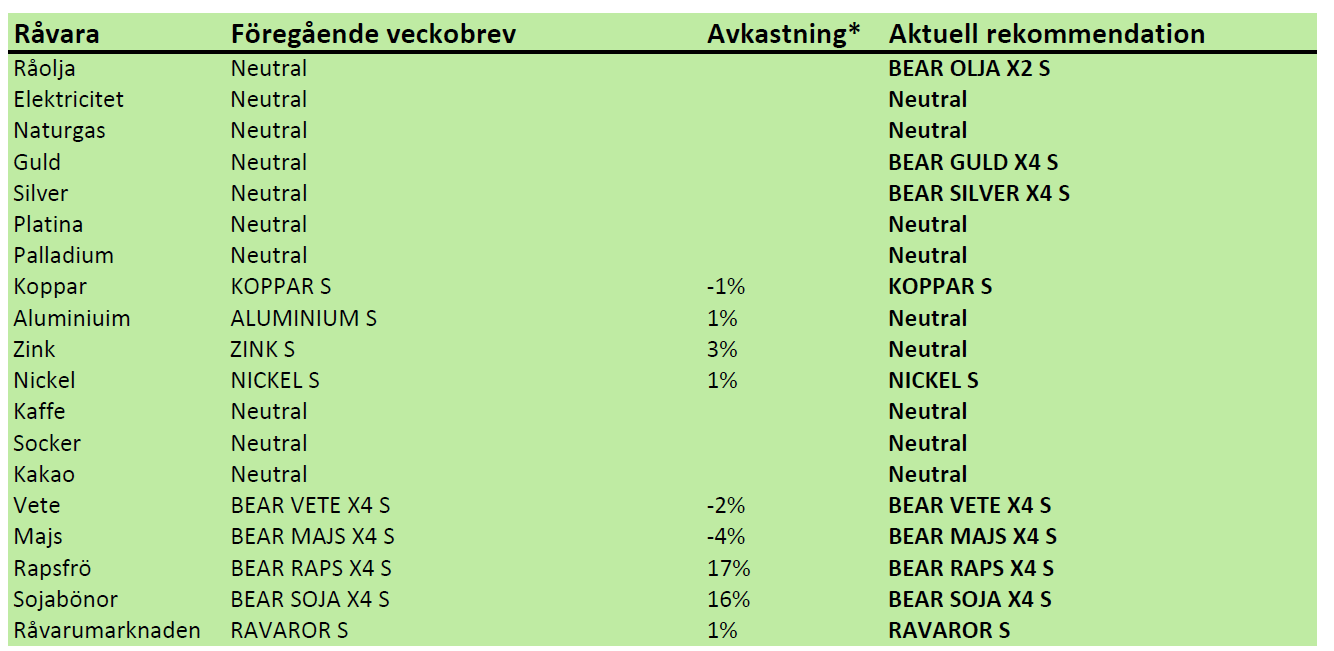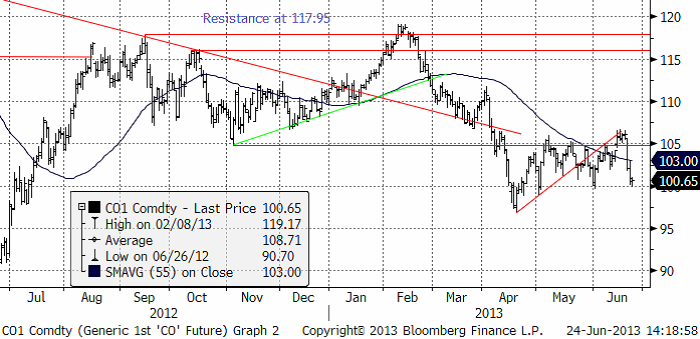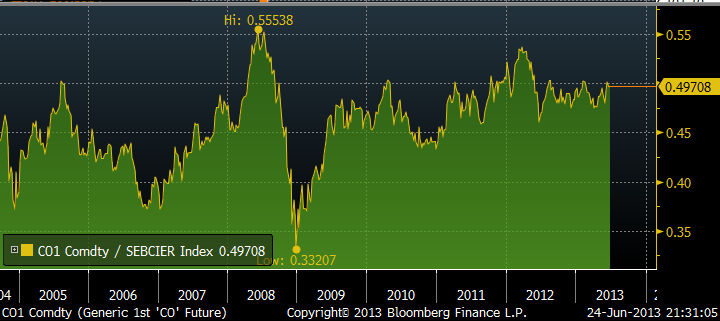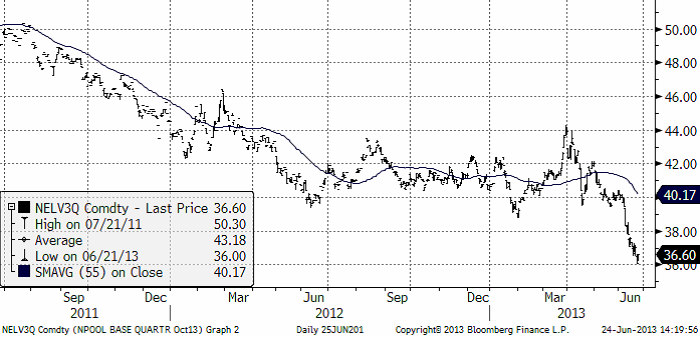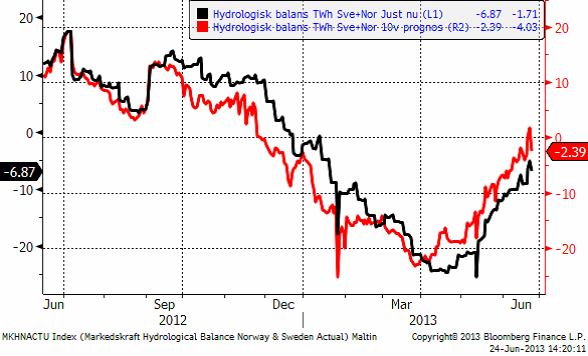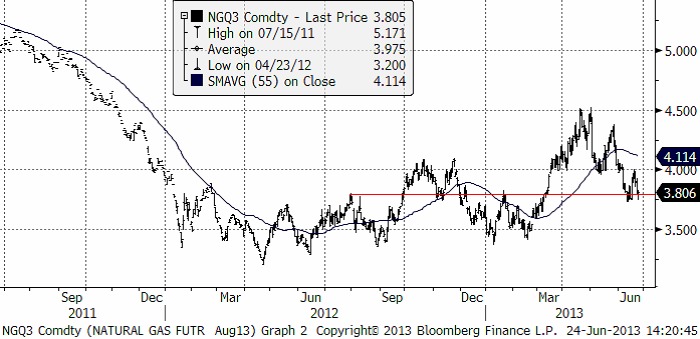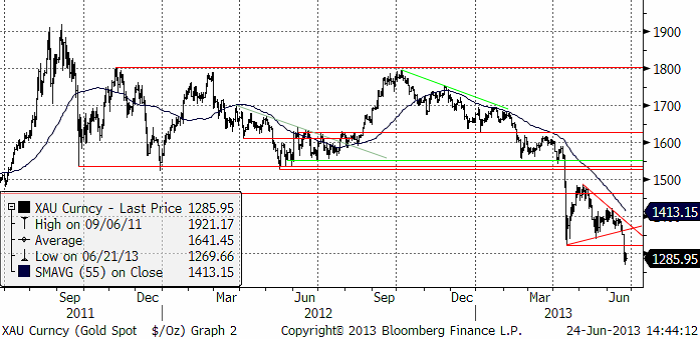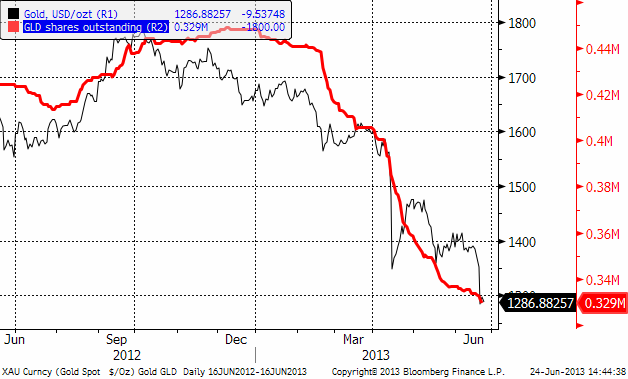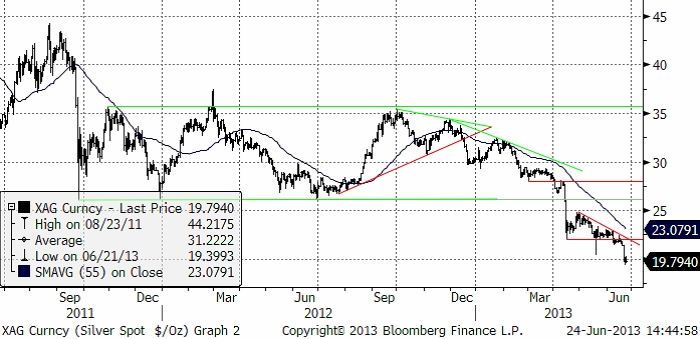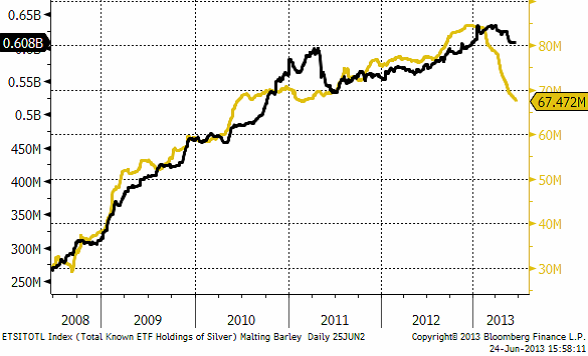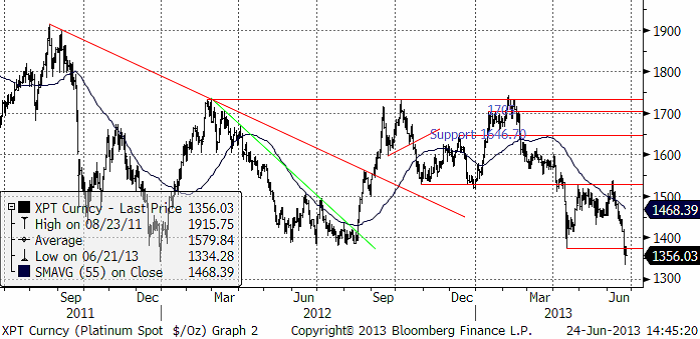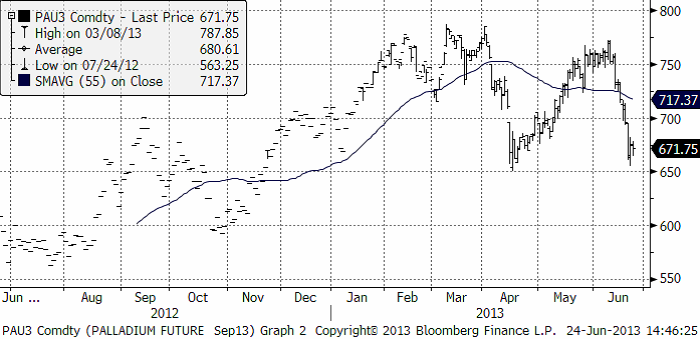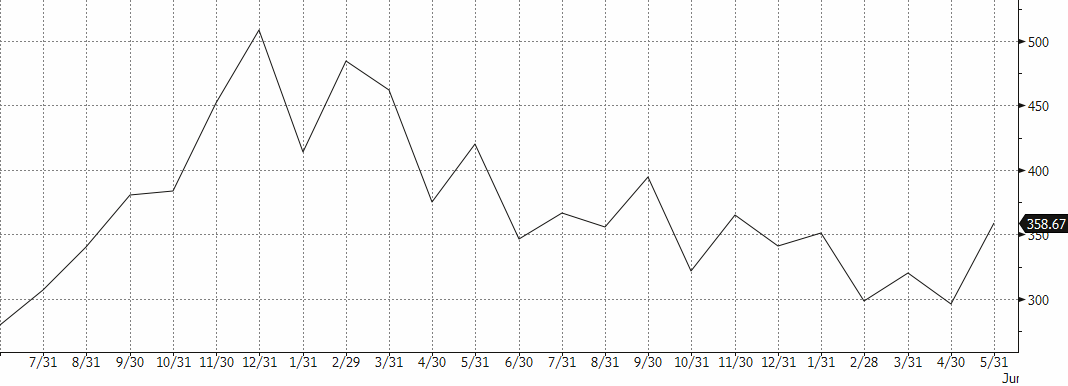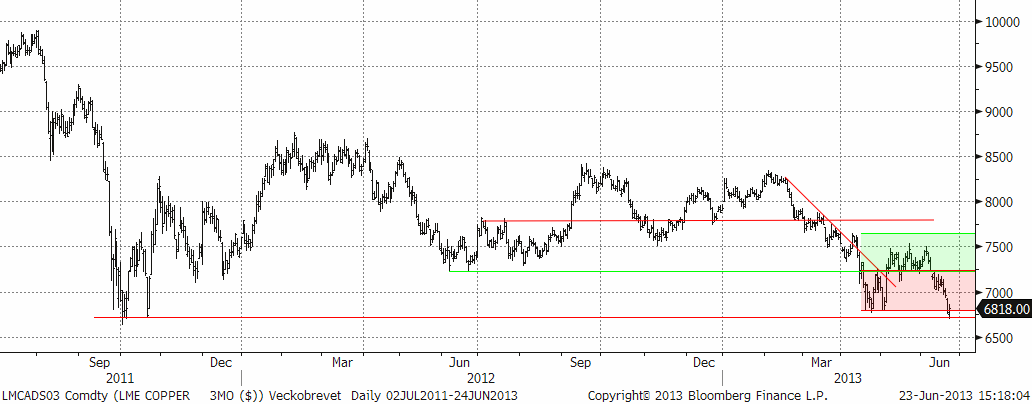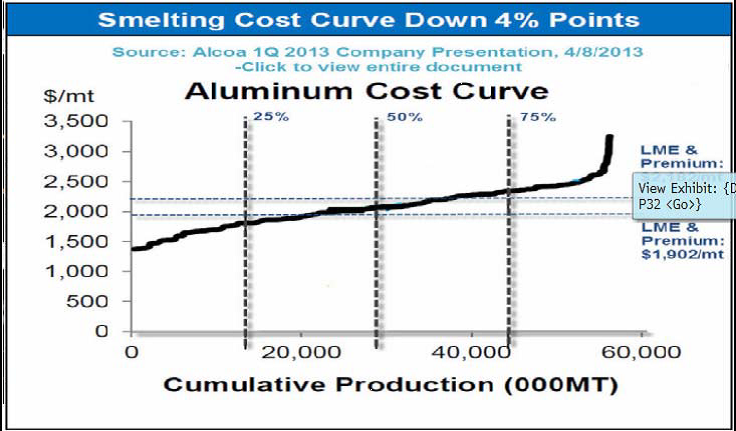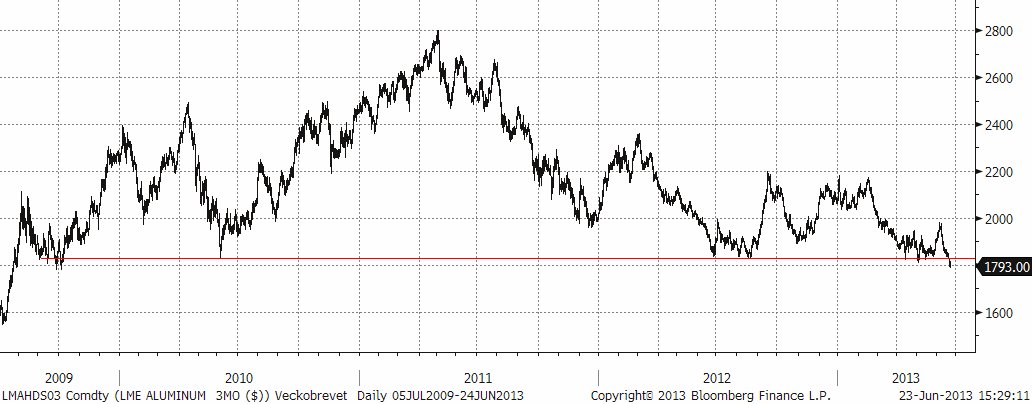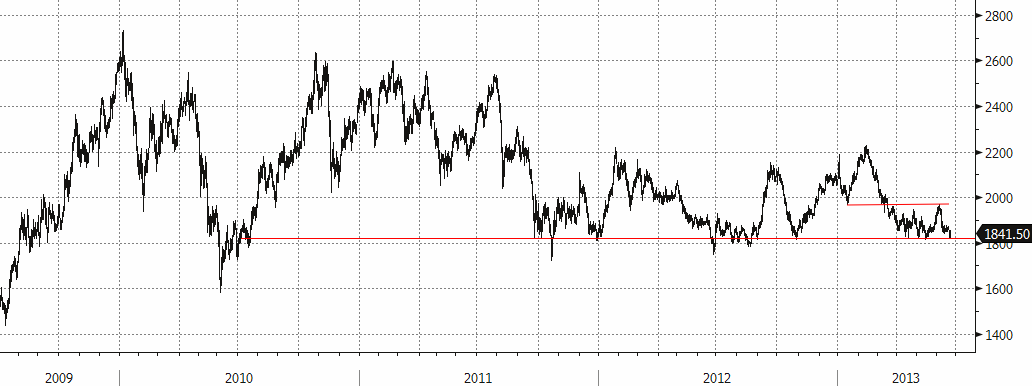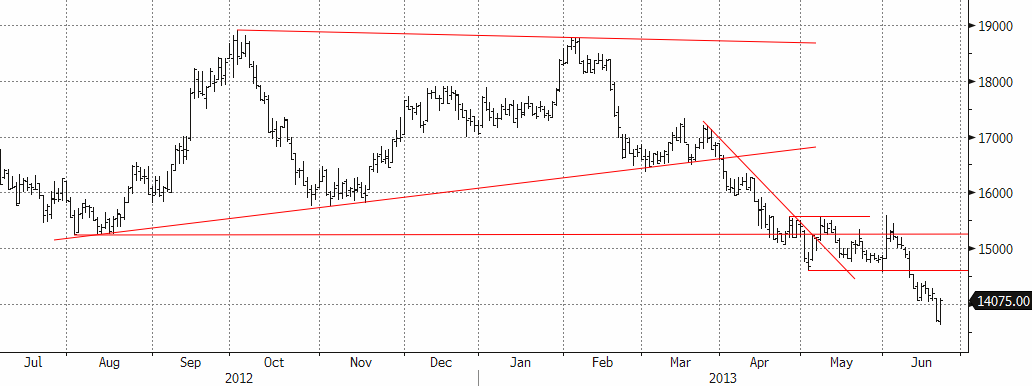Analys
SEB – Råvarukommentarer, 25 juni 2013

Rekommendationer
*) Avkastningen avser 1:1 råvarucertifikat där de ingår i rekommendationen. I den aktuella tabellen ovan har jag tagit prisförändringen den senaste veckan sedan det förra veckobrevet publicerades.
Inledning
Kinas inköpschefsindex för tillverkningsindustrin (PMI) som i maj låg på 50.8, väntas för juni i rapporten som släpps den 1 juli hamna på 50.1. Ett indexvärde >50 indikerar tillväxt. HSBC ”Flash PMI” för Kina, en slags ledande indikator, till den ledande konjunkturindikatorn PMI, som publicerades förra veckan, hamnade dock på 48.3 i förra veckan. Detta betyder att tillväxten i Kinas ekonomi håller på att avta. Kinas PMI ligger nu på den lägsta nivån på nio månader och det går rykten om en ”run on the banks”.
Beskedet från Bernanke och Fed förra onsdagen, att man kan komma att trappa ned obligationsköpen redan senare i år om den amerikanska ekonomin fortsätter att återhämta sig i linje med Feds prognos, satte de finansiella marknaderna i gungning och har gett stora prisrörelser på räntor, valutor, aktier och råvaror. På obligationsmarknaden har amerikanska räntor stigit kraftigt sedan Feds besked och räntan på en 10-årig amerikansk statsobligation ligger i just nu på ca 2.57% jämfört med ungefär 2.20% innan Feds besked i onsdags. Det är den högsta räntenivån sedan mitten på 2011 och uppgången har dragit med sig globala obligationsräntor.
På valutamarknaden följdes Feds besked av en kraftig dollarförstärkning mot flertalet valutor, men främst mot EM- och råvarurelaterade valutor. Även de skandinaviska valutorna har dragits med i rörelserna och försvagades i slutet på veckan mot främst dollarn i marknader med tunn likviditet.
Även guldpriset föll efter Fed och guldet handlas sedan i slutet på veckan under 1 300 dollar, vilket är lägre än botten från den kraftiga nedgången i april. Med minskad riskaptit reagerade också aktiemarknaderna negativ på Feds besked och sålde av under främst onsdagen och torsdagen. Det breda amerikanska aktieindexet S&P500 föll med 2.1% under förra veckan trots en uppgång de första dagarna och en försiktig återhämtning med 0.3% under fredagen. Den här veckan har inletts med nedgångar i Asien (Nikkei -0.4%) samtidigt som trycket på obligationsräntorna består.
I Brasilien har befolkningen startat vad som först såg ut att vara en revolution – riktad mot den socialistiska regeringen. Det började med en spontan urladdning i São Paulo mot höjningen av priset på redan höga bussbiljetter. I skrivande stund pågår protesterna fortfarande, men i mindre omfattning än för en vecka sedan. En lägre efterfrågan på råvaror från andra tillväxtländer, främst Kina, har drabbat råvarulandet Brasilien hårt, i kombination med den styrande presidenten Dilma Rousseffs oförutsägbara ekonomiska detaljpolitik. Priset på järnmalm, socker och kaffe har halverats på två år och priset på soja och majs sjunkit avsevärt sedan i vintras. Till den ekonomiska politikens haverier hör bland annat en skatt på betalningar till landet, ett pristak på bränsle (som drabbar energiföretag, bland annat det nästan kapsejsade flaggskeppet Petrobras), med mera. Inflationen på vanliga konsumentvaror stiger. Minnet av 90-talets inflationstakt på tusentals procent finns kvar. Börsens nedgång övergick i börskrasch för en månad sedan och valutan har rasat. På landets flagga står valspråket ”ordem e progrosso”, [ordning och framsteg] en ironi med det styre som landet har, enligt dem som protesterar. En fallande valuta innebär allt annat lika att inhemsk produktion blir mer lönsam och då ökar den produktionen. Inom jordbruksområdet handlar det om majs, soja, socker och kaffe.
Det här är det sista veckobrevet innan sommaruppehållet. Vi önskar alla en skön och lyckosam sommar i marknaden.
Råolja – Brent
Som nämnt ovan fick Bernankes tal om ett slut på QE och Kinas fallande inköpschefsindex (PMI), marknaden på fall förra veckan. Oljepriset gick ner till 100 dollar, där det finns ett tekniskt stöd.
Det verkar som om ”ingen” har någon insyn i vad som sker i Kina. På en aluminiumkonferens vi deltog i, i Amsterdam i början av förra veckan, lämnades Kina i stort sett utanför diskussionen, därför att ingen hade några konkreta fakta mer än ”7.5% tillväxt” att diskutera.
Norges Storting fattade beslut under måndagen att tillåta E&P i Barents hav, på gränsen till Ryssland. Det antas finnas stora mängder olja och framförallt gas på kontinentalsockeln där, vid mindre än 500 meters havsdjup.
Jämfört med många andra råvaror har oljepriset ännu inte korrigerats nedåt. Nedan ser vi ett diagram över kvoten oljepris / SEB:s råvaruindex. Oljepriset ligger på en ovanligt hög nivå i förhållande till andra råvaror. En kvot på 0.45 (som i diagrammet nedan), en mer ”normal” relation till andra råvarupriser, skulle innebära ett pris på 90 dollar per fat.
Vi väljer att återgå till säljrekommendation på olja och rekommenderar köp av BEAR OLJA X2 S.
Elektricitet
Baissen på elbörsen har fortsatt sedan förra veckobrevet och priset har kommit ner ordentligt. Som vanligt gäller att försöka vara beredd på att köpa, men att vänta på en bekräftelse på att botten är nådd. Vi fortsätter med neutral rekommendation.
Hydrologisk balans backade något när 10-veckors prognos enligt Markedskraft hamnade nådde upp till normal balans (röd kurva nedan).
Priset har kommit ner så pass att det börjar bli intressant att köpa el, men rekommendationen blir än så länge ”neutral”.
Naturgas
Naturgaspriset har backat ner till 3.80 dollar per MMBtu, där ett tekniskt stöd finns. Vi tror att det kan vara intressant att köpa på den här nivån, men vill gärna se en bekräftelse på att prisfallet har stannat av. Rekommendationen blir därför alltjämt ”neutral”.
Guld och Silver
Guldpriset bröt ur triangelformationen på nedsidan och föll rakt genom stödet på 1322 dollar. Tekniskt indikeras nedgång till 1200 eller därunder. Det betyder att den onödiga neutral-rekommendationen vi gav i förra veckobrevet i väntan på utbrott ur triangelformationen, går tillbaka till en säljrekommendation.
Investerare fortsätter att likvidera sina innehav av Gold Spiders, som vi ser nedan. Det var en mycket kort paus, men när prisfallet fortsatte, fortsatte även likvideringen av guld som investering.
Nedan ser vi kursdiagrammet för silver i dollar per troy ounce. Prisfallet har nu nått under 20 dollar.
Medan ETF:ers innahav av guld har rasat i år från 85 miljoner uns till 76 miljoner uns, har innehavet av silver knappast påverkats alls av baissen. Som mest var det 640 miljoner uns i ETF:er och det har bara minskat till 608 miljoner. Skulle silverinvesterarna få för sig att likvidera kan det få silvermarknaden på ännu mer fall. För att komma ikapp guld-ETF:erna skulle silver-EFT:erna nu behöva minska med 50 miljoner uns.
Förra veckan gick vi något onödigt över till neutral rekommendation i väntan på utbrott ur triangeln, och missade prisfallet som kom. Vi går nu tillbaka till att rekommendera såld position, dvs köp av BEAR GULD X4 S och BEAR SILVER X4 S.
Platina & Palladium
Platina föll kraftigt i veckan som gick. Prisfallet bröt flera tekniska stöd. Tekniskt är platina ”översålt”. Frågan är om det finns några fyndköpare som är modiga nog att ge sig ut och köpa.
Septemberkontraktet på palladium har fallit till stödet på 650 dollar per troy uns. Prisfallet har hejdats där, åtminstone temporärt, men det ser inte positivt ut och blir det en rekyl uppåt från den här nivån är det sannolikt enbart ett mycket bra tillfälle att köpa BEAR PALLAD X4 S.
Basmetaller
Veckans utveckling på den makroekonomiska scenen har definitivt inte gynnat metaller och andra industriella råvaror. Priserna har fallit på bred front. Basmetaller och olja är ner 3-5 % under veckan. Värst är rasen för de ädla metallerna med guldet i spetsen, som noteras ner 7 %. Silver är värst med ett ras på 9 %. Dollarn har samtidigt stigit, mot kronan ca 4 % vilket gör basmetallerna i princip är oförändrade under veckan räknat i SEK.
Bernankes tal på onsdagskvällen blev utlösande faktor för rasen under torsdagen. Utvecklingen på räntemarknaden i Kina, där korta räntor steg kraftigt i slutet av veckan, gjorde också sitt för att sprida oro. Marknaden förvånas att centralbanken (i Kina) inte släpper till likviditet i större omfattning. Minskade stimulanser från USA och en likviditetssqueeze i Kina är naturligtvis inte bra för metaller (på kort sikt). Som lök på laxen kom de preliminära inköpsindexsiffrorna (Markits) in svagare än väntat både i Kina och US.
Med lite eftertanke så är nog inte allt så nattsvart. Det faktum att FED börjar fundera på ett avslut av stimulanserna och en normalisering av räntemarknaden, är ett tecken på att tillväxten kommer och att arbetsmarknaden förbättras. Således ett tecken på bättre metallefterfrågan på lite sikt. Den amerikanska konjunkturen växer, Europa går åt rätt håll och Kina växer starkt, om än i en lägre takt än tidigare.
Trots det har det negativa stämningsläget gripit tag i marknaden, vilket riskerar att driva ner priserna ännu lägre. Avvaktan är därför på sin plats tills läget klarnat, framför allt gäller det läget i den kinesiska ekonomin.
Koppar
Om vi ser på koppar isolerat, är egentligen nyhetsflödet ganska ”positivt” i den bemärkelsen att utbudet riskerar att påverkas negativt de kommande månaderna. Det finns risk att det blir ”tight”, åtminstone tillfälligt. Grassberggruvan deklarerade force majeure för alla kopparleveranser för två veckor sedan. Gruvan stängdes på order av den Indonesiska regeringen för en översyn efter en rad dödsolyckor på senare tid (de senaste indikationerna tyder på en snarare återgång än tidigare väntat). Ett jordskred tidigare under året vid den stora Binghamgruvan i Utah US, är stängd sedan flera månader. Bristen är inte lika stor på koppar som för några år sedan, men utbudsstörningarna riskerar att få effekt, om de blir långvariga. Kinas importsiffror från förra månaden visar ett ökat intag av koppar. Delvis är det en eftersläpande säsongseffekt efter det kinesiska nyåret, men icke desto mindre en positiv information till marknaden. Det ryktas samtidigt att regeringen är ute och sonderar för att öka de strategiska inköpen (historiskt har Kina varit stor köpare när priset dippar under $7000).
Som vi skrivit tidigare har vi haft kopparn under bevakning för att gå från neutral till köp. Tekniskt sett har vi bedömt förutsättningarna som goda för kortsiktig uppgång. Trots de senaste veckornas tveksamhet, tar vi fasta på indikationer att det negativa stämningsläget kring koppar håller på att svänga om. Som vi skrivit tidigare tyder mycket på att lagren i Kina har betats av, och att avmattningen av importen är relativt snart övergående (vilket veckans siffra tyder på – se graf).
Kinas kopparimport (1000-tals ton)
Vi skrev förra veckan att de senaste veckornas svaga utveckling sätter kopparn i ett mer neutralt läge i en sidledes trend. Vi skriv vidare att avvaktan kunde vara på sin plats – ”om priset faller under $7000, är det köpläge igen, framför allt om vi når nivåer kring $6800 igen”. Nu är marknaden där och testar av stödnivåerna. Med tanke på den oroliga situationen på finansmarknaden kan det vara värt att vara fortsatt på sidlinjen och bevaka utvecklingen extra noga under veckan.
Vi förväntar oss fortsatt hög volatilitet. Vår kortsiktiga bedömning talar för uppsidan och vi rekommenderar därför köp av BULL KOPPAR X2 S eller X4 S.
Aluminium
Priset har nu ”testat” stödnivåerna vid $1810-20 vid ett flertal tillfällen, och lyckats studsa upp, vilket vi tolkat som ett styrketecken. Förra veckans utveckling med FEDs kommentarer i kombination med oro för Kinas efterfrågan blev dock för mycket. De finansiella aktörerna fick överhanden och priset pressades under ned psykologiskt viktiga $1800- nivån. De senaste veckornas utveckling är ett tecken på att det är för tidigt att se den stora vändningen för aluminium. Lagren är för stora än så länge och det tar tid att ”beta av”. Vi ser ändå långsiktiga tecken på att marknaden dock succesivt håller på att bottna ur.
Högkostnadsproducenterna, framför allt i Kina, förväntas minska utbudet (ännu mer) om priset långvarigt stannar på nuvarande nivåer. Den största aluminiumproducenten Chalco, har redan annonserat att de stänger ytterligare produktionskapacitet motsvarande 380 tton. Den senaste prisutvecklingen aktualiserar vikten av produktions-begränsningar. 30-40 % av den globala produktionskapaciteten är enligt Alcoa olönsamt på dagens prisnivå (inklusive fysiska premier). Se grafen nedan.
Långsiktigt är nivån väldigt intressant för kontraktet ALUMINIUM S (utan hävstång). Det rådande läget på den finansiella marknaden manar dock till avvaktan. Det finns risk för ännu lägre pris på kort sikt.
Zink
Situationen för zink påminner om den för aluminium, både fundamentalt och tekniskt. Vi bedömer zinken som ”billig” ur ett kostnadsperspektiv och nuvarande nivåer är mycket intressanta på lite längre sikt (6-12 månader). I det perspektivet är ZINK S (utan hävstång) att föredra. Men precis som för övriga metaller kan vi inte räkna bort ytterligare press på kort sikt i linje med det allmänna stämningsläget.
Nickel
Nickel uppvisar förnyad svaghet. Priset bröt igenom stödet vid $14000 under veckan. Det verkar inte finnas någon hejd på prisfallet. Marknaden debatterar var produktionskostnaden ligger för nickelproduktionen i Kina.
Produktionstekniken av s.k. Nickel Pig Iron i Kina har utvecklats med s.k. Rotary Kiln Electric Furnaces (RKEF) teknik, vilken i genomsnitt sänker hela kostnadskurvan. På Ryans Notes Ferrolegeringskonferens i Amsterdam i förra veckan deklarerades det att nivån sannolikt ligger kring $13000. Samtidigt är de traditionella produktionsteknikerna sannolikt väldigt olönsamma på nuvarande nivåer. Att producenterna i gruvledet har problem, råder det ingen tvekan om. Vi har tidigare rapporterat om produktionsneddragningar i Australien, och det förväntas komma mer.
Klart är att effekten av RKEF-tekniken riskerar att flytta ner nivån där utbudsminskningarna verkligen får effekt. Priset har brutit viktiga stödnivåer, och vi får gå tillbaka till juli 2009 för att hitta lägre priser.3-månaders nickel noterades i $13628 som lägst på midsommarafton, men steg kraftigt mot slutet av dagen för att stänga över $14000. Vi kvarstår med bedömningen att nivåerna är mycket attraktiva på 6-12 månaders sikt. I det perspektivet är NICKEL S (utan hävstång) att föredra. Viss försiktighet rekommenderas på kort sikt med tanke på den senaste utvecklingen på de finansiella marknaderna.
Nickel från juni 2012
Nickel från juni 2008
[box]SEB Veckobrev Veckans råvarukommentar är producerat av SEB Merchant Banking och publiceras i samarbete och med tillstånd på Råvarumarknaden.se[/box]
Disclaimer
The information in this document has been compiled by SEB Merchant Banking, a division within Skandinaviska Enskilda Banken AB (publ) (“SEB”).
Opinions contained in this report represent the bank’s present opinion only and are subject to change without notice. All information contained in this report has been compiled in good faith from sources believed to be reliable. However, no representation or warranty, expressed or implied, is made with respect to the completeness or accuracy of its contents and the information is not to be relied upon as authoritative. Anyone considering taking actions based upon the content of this document is urged to base his or her investment decisions upon such investigations as he or she deems necessary. This document is being provided as information only, and no specific actions are being solicited as a result of it; to the extent permitted by law, no liability whatsoever is accepted for any direct or consequential loss arising from use of this document or its contents.
About SEB
SEB is a public company incorporated in Stockholm, Sweden, with limited liability. It is a participant at major Nordic and other European Regulated Markets and Multilateral Trading Facilities (as well as some non-European equivalent markets) for trading in financial instruments, such as markets operated by NASDAQ OMX, NYSE Euronext, London Stock Exchange, Deutsche Börse, Swiss Exchanges, Turquoise and Chi-X. SEB is authorized and regulated by Finansinspektionen in Sweden; it is authorized and subject to limited regulation by the Financial Services Authority for the conduct of designated investment business in the UK, and is subject to the provisions of relevant regulators in all other jurisdictions where SEB conducts operations. SEB Merchant Banking. All rights reserved.
Analys
Tightening fundamentals – bullish inventories from DOE

The latest weekly report from the US DOE showed a substantial drawdown across key petroleum categories, adding more upside potential to the fundamental picture.

Commercial crude inventories (excl. SPR) fell by 5.8 million barrels, bringing total inventories down to 415.1 million barrels. Now sitting 11% below the five-year seasonal norm and placed in the lowest 2015-2022 range (see picture below).
Product inventories also tightened further last week. Gasoline inventories declined by 2.1 million barrels, with reductions seen in both finished gasoline and blending components. Current gasoline levels are about 3% below the five-year average for this time of year.
Among products, the most notable move came in diesel, where inventories dropped by almost 4.1 million barrels, deepening the deficit to around 20% below seasonal norms – continuing to underscore the persistent supply tightness in diesel markets.
The only area of inventory growth was in propane/propylene, which posted a significant 5.1-million-barrel build and now stands 9% above the five-year average.
Total commercial petroleum inventories (crude plus refined products) declined by 4.2 million barrels on the week, reinforcing the overall tightening of US crude and products.


Analys
Bombs to ”ceasefire” in hours – Brent below $70

A classic case of “buy the rumor, sell the news” played out in oil markets, as Brent crude has dropped sharply – down nearly USD 10 per barrel since yesterday evening – following Iran’s retaliatory strike on a U.S. air base in Qatar. The immediate reaction was: “That was it?” The strike followed a carefully calibrated, non-escalatory playbook, avoiding direct threats to energy infrastructure or disruption of shipping through the Strait of Hormuz – thus calming worst-case fears.

After Monday morning’s sharp spike to USD 81.4 per barrel, triggered by the U.S. bombing of Iranian nuclear facilities, oil prices drifted sideways in anticipation of a potential Iranian response. That response came with advance warning and caused limited physical damage. Early this morning, both the U.S. President and Iranian state media announced a ceasefire, effectively placing a lid on the immediate conflict risk – at least for now.
As a result, Brent crude has now fallen by a total of USD 12 from Monday’s peak, currently trading around USD 69 per barrel.
Looking beyond geopolitics, the market will now shift its focus to the upcoming OPEC+ meeting in early July. Saudi Arabia’s decision to increase output earlier this year – despite falling prices – has drawn renewed attention considering recent developments. Some suggest this was a response to U.S. pressure to offset potential Iranian supply losses.
However, consensus is that the move was driven more by internal OPEC+ dynamics. After years of curbing production to support prices, Riyadh had grown frustrated with quota-busting by several members (notably Kazakhstan). With Saudi Arabia cutting up to 2 million barrels per day – roughly 2% of global supply – returns were diminishing, and the risk of losing market share was rising. The production increase is widely seen as an effort to reassert leadership and restore discipline within the group.
That said, the FT recently stated that, the Saudis remain wary of past missteps. In 2018, Riyadh ramped up output at Trump’s request ahead of Iran sanctions, only to see prices collapse when the U.S. granted broad waivers – triggering oversupply. Officials have reportedly made it clear they don’t intend to repeat that mistake.
The recent visit by President Trump to Saudi Arabia, which included agreements on AI, defense, and nuclear cooperation, suggests a broader strategic alignment. This has fueled speculation about a quiet “pump-for-politics” deal behind recent production moves.
Looking ahead, oil prices have now retraced the entire rally sparked by the June 13 Israel–Iran escalation. This retreat provides more political and policy space for both the U.S. and Saudi Arabia. Specifically, it makes it easier for Riyadh to scale back its three recent production hikes of 411,000 barrels each, potentially returning to more moderate increases of 137,000 barrels for August and September.
In short: with no major loss of Iranian supply to the market, OPEC+ – led by Saudi Arabia – no longer needs to compensate for a disruption that hasn’t materialized, especially not to please the U.S. at the cost of its own market strategy. As the Saudis themselves have signaled, they are unlikely to repeat previous mistakes.
Conclusion: With Brent now in the high USD 60s, buying oil looks fundamentally justified. The geopolitical premium has deflated, but tensions between Israel and Iran remain unresolved – and the risk of missteps and renewed escalation still lingers. In fact, even this morning, reports have emerged of renewed missile fire despite the declared “truce.” The path forward may be calmer – but it is far from stable.
Analys
A muted price reaction. Market looks relaxed, but it is still on edge waiting for what Iran will do

Brent crossed the 80-line this morning but quickly fell back assigning limited probability for Iran choosing to close the Strait of Hormuz. Brent traded in a range of USD 70.56 – 79.04/b last week as the market fluctuated between ”Iran wants a deal” and ”US is about to attack Iran”. At the end of the week though, Donald Trump managed to convince markets (and probably also Iran) that he would make a decision within two weeks. I.e. no imminent attack. Previously when when he has talked about ”making a decision within two weeks” he has often ended up doing nothing in the end. The oil market relaxed as a result and the week ended at USD 77.01/b which is just USD 6/b above the year to date average of USD 71/b.

Brent jumped to USD 81.4/b this morning, the highest since mid-January, but then quickly fell back to a current price of USD 78.2/b which is only up 1.5% versus the close on Friday. As such the market is pricing a fairly low probability that Iran will actually close the Strait of Hormuz. Probably because it will hurt Iranian oil exports as well as the global oil market.
It was however all smoke and mirrors. Deception. The US attacked Iran on Saturday. The attack involved 125 warplanes, submarines and surface warships and 14 bunker buster bombs were dropped on Iranian nuclear sites including Fordow, Natanz and Isfahan. In response the Iranian Parliament voted in support of closing the Strait of Hormuz where some 17 mb of crude and products is transported to the global market every day plus significant volumes of LNG. This is however merely an advise to the Supreme leader Ayatollah Ali Khamenei and the Supreme National Security Council which sits with the final and actual decision.
No supply of oil is lost yet. It is about the risk of Iran closing the Strait of Hormuz or not. So far not a single drop of oil supply has been lost to the global market. The price at the moment is all about the assessed risk of loss of supply. Will Iran choose to choke of the Strait of Hormuz or not? That is the big question. It would be painful for US consumers, for Donald Trump’s voter base, for the global economy but also for Iran and its population which relies on oil exports and income from selling oil out of that Strait as well. As such it is not a no-brainer choice for Iran to close the Strait for oil exports. And looking at the il price this morning it is clear that the oil market doesn’t assign a very high probability of it happening. It is however probably well within the capability of Iran to close the Strait off with rockets, mines, air-drones and possibly sea-drones. Just look at how Ukraine has been able to control and damage the Russian Black Sea fleet.
What to do about the highly enriched uranium which has gone missing? While the US and Israel can celebrate their destruction of Iranian nuclear facilities they are also scratching their heads over what to do with the lost Iranian nuclear material. Iran had 408 kg of highly enriched uranium (IAEA). Almost weapons grade. Enough for some 10 nuclear warheads. It seems to have been transported out of Fordow before the attack this weekend.
The market is still on edge. USD 80-something/b seems sensible while we wait. The oil market reaction to this weekend’s events is very muted so far. The market is still on edge awaiting what Iran will do. Because Iran will do something. But what and when? An oil price of 80-something seems like a sensible level until something do happen.
-

 Nyheter4 veckor sedan
Nyheter4 veckor sedanStor uppsida i Lappland Guldprospekterings aktie enligt analys
-

 Nyheter4 veckor sedan
Nyheter4 veckor sedanSilverpriset släpar efter guldets utveckling, har mer uppsida
-

 Nyheter3 veckor sedan
Nyheter3 veckor sedanUppgången i oljepriset planade ut under helgen
-

 Nyheter2 veckor sedan
Nyheter2 veckor sedanMahvie Minerals växlar spår – satsar fullt ut på guld
-

 Nyheter3 veckor sedan
Nyheter3 veckor sedanLåga elpriser i sommar – men mellersta Sverige får en ökning
-

 Analys3 veckor sedan
Analys3 veckor sedanVery relaxed at USD 75/b. Risk barometer will likely fluctuate to higher levels with Brent into the 80ies or higher coming 2-3 weeks
-

 Nyheter2 veckor sedan
Nyheter2 veckor sedanOljan, guldet och marknadens oroande tystnad
-

 Nyheter2 veckor sedan
Nyheter2 veckor sedanJonas Lindvall är tillbaka med ett nytt oljebolag, Perthro, som ska börsnoteras


